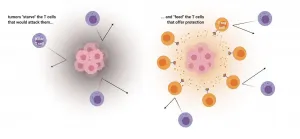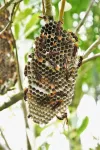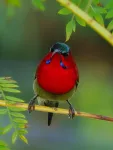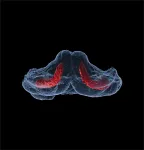(Press-News.org) PITTSBURGH, Feb. 15, 2021 - By capitalizing on a convergence of chemical, biological and artificial intelligence advances, University of Pittsburgh School of Medicine scientists have developed an unusually fast and efficient method for discovering tiny antibody fragments with big potential for development into therapeutics against deadly diseases.
The technique, published today in the journal Cell Systems, is the same process the Pitt team used to extract tiny SARS-CoV-2 antibody fragments from llamas, which could become an inhalable COVID-19 treatment for humans. This approach has the potential to quickly identify multiple potent nanobodies that target different parts of a pathogen--thwarting variants.
"Most of the vaccines and treatments against SARS-CoV-2 target the spike protein, but if that part of the virus mutates, which we know it is, those vaccines and treatments may be less effective," said senior author Yi Shi, Ph.D., assistant professor of cell biology at Pitt. "Our approach is an efficient way to develop therapeutic cocktails consisting of multiple nanobodies that can launch a multipronged attack to neutralize the pathogen."
Shi and his team specialize in finding nanobodies--which are small, highly specific fragments of antibodies produced by llamas and other camelids. Nanobodies are particularly attractive for development into therapeutics because they are easy to produce and bioengineer. In addition, they feature high stability and solubility, and can be aerosolized and inhaled, rather than administered through intravenous infusion, like traditional antibodies.
By immunizing a llama with a piece of a pathogen, the animal's immune system produces a plethora of mature nanobodies in about two months. Then it's a matter of teasing out which nanobodies are best at neutralizing the pathogen--and most promising for development into therapies for humans.
That's where Shi's "high-throughput proteomics strategy" comes into play.
"Using this new technique, in a matter of days we're typically able to identify tens of thousands of distinct, highly potent nanobodies from the immunized llama serum and survey them for certain characteristics, such as where they bind to the pathogen," Shi said. "Prior to this approach, it has been extremely challenging to identify high-affinity nanobodies."
After drawing a llama blood sample rich in mature nanobodies, the researchers isolate those nanobodies that bind specifically to the target of interest on the pathogen. The nanobodies are then broken down to release small "fingerprint" peptides that are unique to each nanobody. These fingerprint peptides are placed into a mass spectrometer, which is a machine that measures their mass. By knowing their mass, the scientists can figure out their amino acid sequence--the protein building blocks that determine the nanobody's structure. Then, from the amino acids, the researchers can work backward to DNA--the directions for building more nanobodies.
Simultaneously, the amino acid sequence is uploaded to a computer outfitted with artificial intelligence software. By rapidly sifting through mountains of data, the program "learns" which nanobodies bind the tightest to the pathogen and where on the pathogen they bind. In the case of most of the currently available COVID-19 therapeutics, this is the spike protein, but recently it has become clear that some sites on the spike are prone to mutations that change its shape and allow for antibody "escape." Shi's approach can select for binding sites on the spike that are evolutionarily stable, and therefore less likely to allow new variants to slip past.
Finally, the directions for building the most potent and diverse nanobodies can then be fed into vats of bacterial cells, which act as mini factories, churning out orders of magnitude more nanobodies compared to the human cells required to produce traditional antibodies. Bacterial cells double in 10 minutes, effectively doubling the nanobodies with them, whereas human cells take 24 hours to do the same.
"This drastically reduces the cost of producing these therapeutics," said Shi.
Shi and his team believe their technology could be beneficial for more than just developing therapeutics against COVID-19--or even the next pandemic.
"The possible uses of highly potent and specific nanobodies that can be identified quickly and inexpensively are tremendous," said Shi. "We're exploring their use in treating cancer and neurodegenerative diseases. Our technique could even be used in personalized medicine, developing specific treatments for mutated superbugs for which every other antibiotic has failed."
INFORMATION:
Additional researchers on this publication are Yufei Xiang and Jianquan Xu, Ph.D., both of Pitt; Zhe Sang of Pitt and Carnegie Mellon University; and Lirane Bitton and Dina Schneidman-Duhovny, Ph.D., both of the Hebrew University of Jerusalem.
This research was supported by the UPMC Aging Institute, National Institutes of Health grant 1R35GM137905-01, Israel Science Foundation grant 1466/18, the Ministry of Science and Technology of Israel and the Hebrew University of Jerusalem Center for Interdisciplinary Data Science Research.
To read this release online or share it, visit https://www.upmc.com/media/news/021521-shi-massspecproteomics [when embargo lifts].
About the University of Pittsburgh School of Medicine
As one of the nation's leading academic centers for biomedical research, the University of Pittsburgh School of Medicine integrates advanced technology with basic science across a broad range of disciplines in a continuous quest to harness the power of new knowledge and improve the human condition. Driven mainly by the School of Medicine and its affiliates, Pitt has ranked among the top 10 recipients of funding from the National Institutes of Health since 1998. In rankings recently released by the National Science Foundation, Pitt ranked fifth among all American universities in total federal science and engineering research and development support.
Likewise, the School of Medicine is equally committed to advancing the quality and strength of its medical and graduate education programs, for which it is recognized as an innovative leader, and to training highly skilled, compassionate clinicians and creative scientists well-equipped to engage in world-class research. The School of Medicine is the academic partner of UPMC, which has collaborated with the University to raise the standard of medical excellence in Pittsburgh and to position health care as a driving force behind the region's economy. For more information about the School of Medicine, see http://www.medschool.pitt.edu.
http://www.upmc.com/media
Contact: Erin Hare
Mobile: 412-738-1097
E-mail: HareE@upmc.edu
Contact: Allison Hydzik
Office: 412-647-9975
Mobile: 412-559-2431
E-mail: HydzikAM@upmc.edu
What The Study Did: Data from four studies of children and adolescents exposed to major U.S. hurricanes were pooled to examine posttraumatic stress symptoms after those events and the factors associated with them.
Authors: Betty S. Lai, Ph.D., of Boston College in Chestnut Hill, Massachusetts, is the corresponding author.
To access the embargoed study: Visit our For The Media website at this link https://media.jamanetwork.com/
(doi:10.1001/jamanetworkopen.2020.36682)
Editor's Note: The article includes conflict of interest and funding/support disclosures. Please see the article ...
Scientists say they have discovered a potential new target for immunotherapy of malignant brain tumors, which so far have resisted the ground-breaking cancer treatment based on harnessing the body's immune system. The discovery, reported in the journal END ...
RIVERSIDE, Calif. -- Materials having excess electrons are typically conductors. However, moiré patterns -- interference patterns that typically arise when one object with a repetitive pattern is placed over another with a similar pattern -- can suppress electrical conductivity, a study led by physicists at the University of California, Riverside, has found.
In the lab, the researchers overlaid a single monolayer of tungsten disulfide (WS2) on a single monolayer of tungsten diselenide (WSe2) and aligned the two layers against each other to generate large-scale moiré patterns. The atoms in both the WS2 and WSe2 layers are arranged in a two-dimensional honeycomb lattice with a periodicity, ...
Engineers at the University of California San Diego have developed a soft, stretchy skin patch that can be worn on the neck to continuously track blood pressure and heart rate while measuring the wearer's levels of glucose as well as lactate, alcohol or caffeine. It is the first wearable device that monitors cardiovascular signals and multiple biochemical levels in the human body at the same time.
"This type of wearable would be very helpful for people with underlying medical conditions to monitor their own health on a regular basis," said Lu Yin, a nanoengineering Ph.D. student at UC San Diego and co-first author of the study published Feb. 15 in Nature Biomedical Engineering. "It would also serve as a great tool for remote patient monitoring, ...
PITTSBURGH, Feb. 15, 2021 - A paper published today in Nature shows how chemicals in the areas surrounding tumors--known as the tumor microenvironment--subvert the immune system and enable cancer to evade attack. These findings suggest that an existing drug could boost cancer immunotherapy.
The study was conducted by a team of scientists at UPMC Hillman Cancer Center and the University of Pittsburgh School of Medicine, led by Greg Delgoffe, Ph.D., Pitt associate professor of immunology. By disrupting the effect of the tumor microenvironment on immune cells in mice, the researchers were able to shrink tumors, prolong survival and increase sensitivity to immunotherapy.
"The majority of people don't respond to immunotherapy," said Delgoffe. "The reason ...
Researchers have found a way to use light and a single electron to communicate with a cloud of quantum bits and sense their behaviour, making it possible to detect a single quantum bit in a dense cloud.
The researchers, from the University of Cambridge, were able to inject a 'needle' of highly fragile quantum information in a 'haystack' of 100,000 nuclei. Using lasers to control an electron, the researchers could then use that electron to control the behaviour of the haystack, making it easier to find the needle. They were able to detect the 'needle' with a precision of 1.9 parts per million: high enough to detect a single quantum bit in this large ensemble.
The technique makes it possible to send highly fragile ...
[Images and video available: see notes to editors]
Wasps provide crucial support to their extended families by babysitting at neighbouring nests, according to new research by a team of biologists from the universities of Bristol, Exeter and UCL published today [15 February] in Nature Ecology and Evolution.
The findings suggest that animals should often seek to help more distant relatives if their closest kin are less in need.
Dr Patrick Kennedy, lead author and Marie Curie research fellow in the School of Biological Sciences at the University of Bristol, said: "These wasps can act like rich family members lending a hand to their second cousins. If there's not much more you can do to help your immediate family, you can ...
Feathers are a sleek, intricate evolutionary innovation that makes flight possible for birds, but in addition to their stiff, aerodynamic feathers used for flight, birds also keep a layer of soft, fluffy down feathers between their bodies and their outermost feathers to regulate body temperature.
Using the Smithsonian's collection of 625,000 bird specimens, Sahas Barve, a Peter Buck Fellow at the Smithsonian's National Museum of Natural History, led a new study to examine feathers across 249 species of Himalayan songbirds, finding that birds living at higher elevations have more of the fluffy down--the type of feathers humans stuff their jackets with--than birds from lower elevations. Published ...
Ciliopathies are genetic disorders caused by defects in the structure and function of cilia, microtubule-based organelles present on the surface of almost every cell in the human body which play crucial roles in cell signalling. Ciliopathies present a wide range of often severe clinical symptoms, frequently affecting the head and face and leading to conditions such as cleft palate and micrognathia (an underdeveloped lower jaw that can impair feeding and breathing). While we understand many of the genetic causes of human ciliopathies, they are only half the story: the question remains as to why, at a cellular level, defective cilia cause developmental craniofacial abnormalities. Researchers have now discovered that ciliopathic micrognathia in an animal model results from abnormal skeletal ...
Years of suffering and billions of euro in global health care costs, arising from osteoporosis-related bone fractures, could be eliminated using big data to target vulnerable patients, according to researchers at Lero, the Science Foundation Ireland Research Centre for Software.
A study of 36,590 patients who underwent bone mineral density scans in the West of Ireland between January 2000 and November 2018, found that many fractures are potentially preventable by identifying those at greatest risk before they fracture, and initiating proven, safe, low-cost effective interventions.
The multi-disciplinary study, ...






